NCERT Based Activity: Diversity in the Living World | Science for Class 6 PDF Download
Activity 2.1: Let us explore and record
Activity:
- Plan for a nature walk with your teacher to a park or a nearby forest.
- While on the nature walk, observe different plants, insects, birds, and other animals. Also, note the weather conditions, whether it is hot, cold, windy and so on.
- You can collect different types of fallen leaves or flowers and create a scrapbook.
- Take care of the plants and animals in nature. Ensure that you do not disturb the plants and animals in the park. Do not pluck leaves and flowers.
Record your observations in Table 2.1 about the features of stems, leaves, flowers and anything interesting in various plants. Some examples have been given for you in Fig and Table 2.1.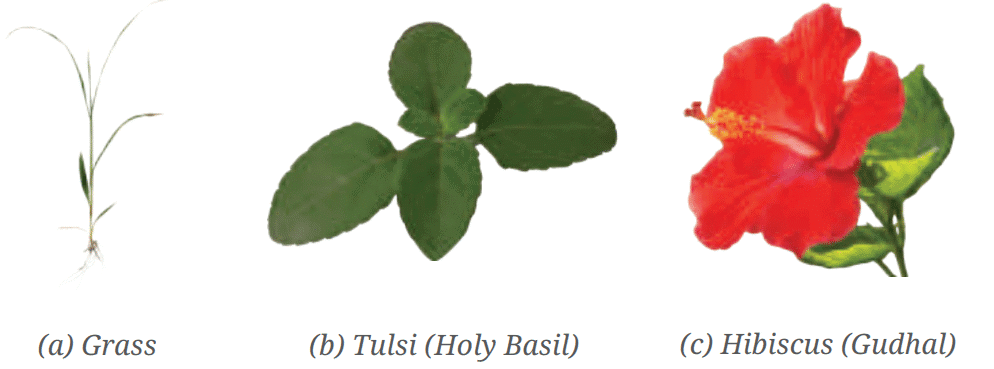 Examples of different features of some plants
Examples of different features of some plants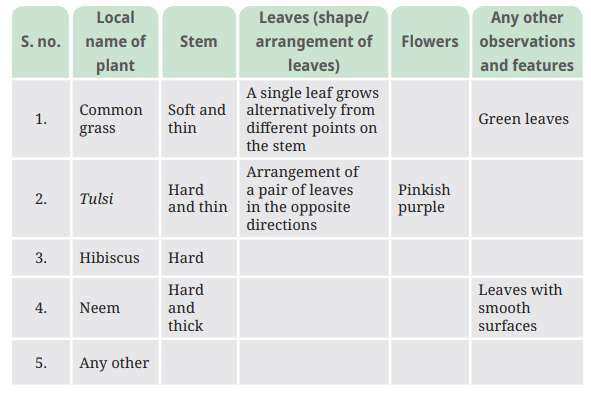 Table 2.1
Table 2.1
Ans: Observations of Different Plants: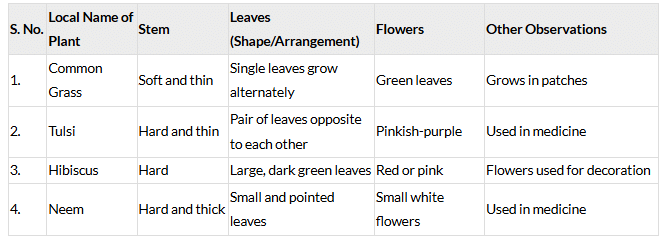
- Plants have different types of stems (soft, hard, thick).
- Leaves vary in shape and arrangement.
- Flowers differ in color, shape, and scent.
What similarities and differences did you find among the plants that you observed? You must have observed that plants have a variety of features such as—
- Tall/short, hard/soft stem
- Different shapes of leaves and their arrangement on the stem or branches
- Flowers varying in colour, shape, and scent. Now, create a list of animals you observed during this walk or from your previous experiences.
Record the places where they live, the food they eat and the ways they move around in Table 2.2. Some examples have been provided for you.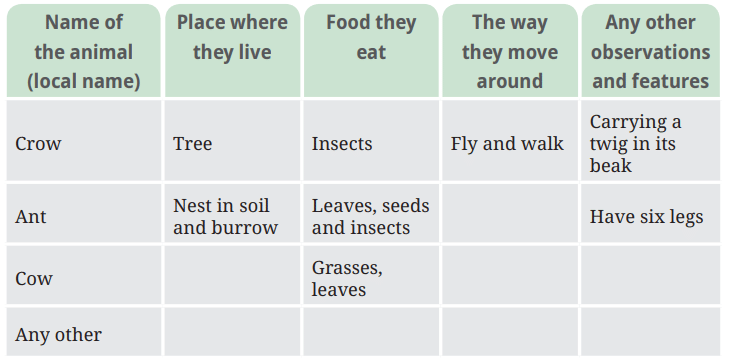 Table 2.2
Table 2.2
Ans: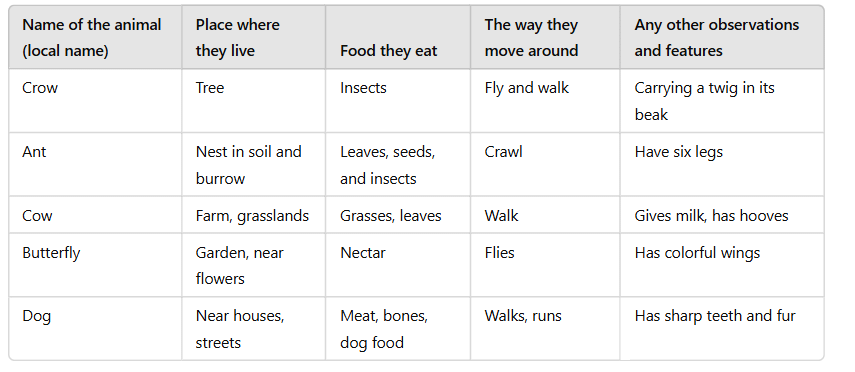
- Different animals have unique habitats, diets, and movement styles.
- Some live in trees (like crows), others in soil (like ants), and some on land (like cows and dogs).
- Their food varies from insects and nectar to grass and meat.
- They move in different ways—flying, walking, crawling, or swimming. These observations highlight the diversity of animal life and their adaptations to their environments.
Activity 2.2: Let us appreciate
Activity:
- Close your eyes for 30 seconds and think of one plant and one animal that you have closely observed and have appreciated very much.
- Now each one of you can draw the plant and animal that you thought of on the blackboard.
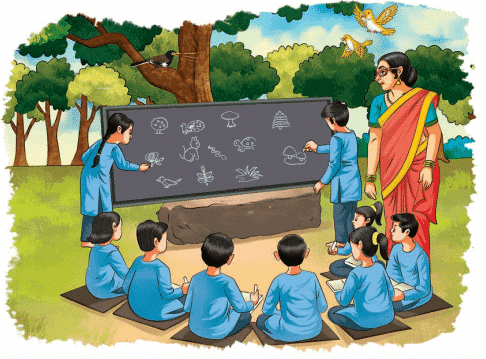
- What are your observations about the various plants and animals that have been drawn?
- How many different plants and animals did the entire class draw on the blackboard?
- Do you think that there may be many more varieties of plants and animals other than those drawn on the board?
Ans: Plant Observed:
- Mango Tree
- Tall, brown stem, wide leaves, bears fruit.
Animal Observed:
- Peacock
- Colorful feathers, can fly short distances, dances in rain.
Classroom Discussion:
- The class drew different plants and animals, showing biodiversity.
- There are many more plants and animals than what we observed.
- This activity highlights the vast diversity in nature.
Activity 2.3: Let us group
Activity:
- Collect pictures of various other plants and animals. Cut their pictures from old magazines, newspapers, charts and other sources. Paste each of these pictures on a different card.
- Divide your class in groups of 5–6 students each.
- Pool the cards prepared by the students in your group.
- Observe various features of plants and animals shown on the cards.
- Recall the features of plants and animals that you have listed in Tables 2.1 and 2.2.
- Group them on the basis of common features.
Share and discuss the basis of grouping you have made with other groups in your class. You will be surprised to see that the basis used by different groups may vary. What do you think are the reasons behind it? Different students might have chosen different common features for the grouping.
For example, some students may have chosen the height of plants as the basis for grouping while others might have chosen presence or absence of flowers as the basis for grouping of plants (See Fig. 2.2).  Some possible criteria of groupings of plants and animalsYou may have grouped animals based on varied features, such as what they eat, where they live, what colour they are and how they move. What is the importance of grouping? Grouping makes it easier to understand and study plants and animals on the basis of their similarities and differences.
Some possible criteria of groupings of plants and animalsYou may have grouped animals based on varied features, such as what they eat, where they live, what colour they are and how they move. What is the importance of grouping? Grouping makes it easier to understand and study plants and animals on the basis of their similarities and differences.
Ans: Grouping Based on Common Features: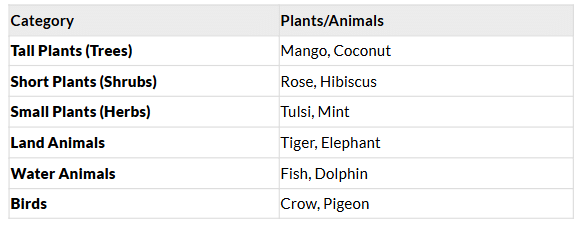
Conclusion:
- Grouping makes it easier to study plants and animals.
- Different features can be used for classification (size, habitat, food).
Activity 2.4: Let us group plants
Activity:
- Let us go on a nature walk again for some more interesting observations.
- Look closely at the heights of different plants. Are these plants shorter than you, as tall as you, or taller than you?
- Is the stem brown or green? Touch and feel their stems and try to bend them gently. Can you bend the stem easily, or is it stiff? Take care that stems do not break.
- Also, observe from where the branches of the plants arise—whether they arise close to the ground or higher up on the stem. Fill in your observations in Table 2.3. A few examples are already given.
 Types of Plant
Types of Plant
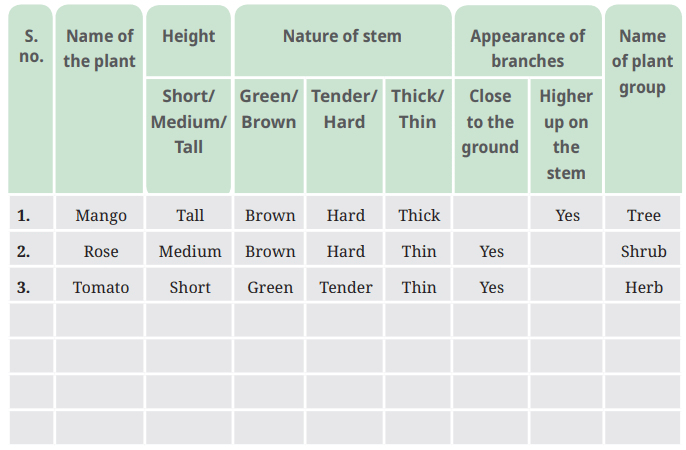 Table 2.4
Table 2.4
Ans: Conclusion:
Conclusion:
- Trees are tall with thick, hard stems.
- Shrubs have multiple branches close to the ground.
- Herbs have soft, green stems.
Activity 2.5: Let us compare leaves
Activity:
- Look at the leaves of different plants collected by you, during the nature walk.
- Do you notice the variation in the shape and structure of these leaves? You may observe thin lines on the leaves of the plants (Fig. 2.4a). These are veins.
- What differences do you see in the veins of leaves shown in Fig. 2.4a and Fig. 2.4b?
 Fig 2.4: Leaves Venation
Fig 2.4: Leaves Venation
Ans: Differences: Reticulate venation has a network of veins. Parallel venation has straight veins running parallel.
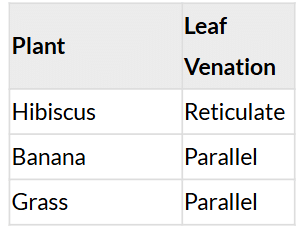
i. Do you think that plants can be grouped on the basis of venation present in their leaves?
Ans: Yes, plants can be grouped based on the venation (the pattern of veins) in their leaves. There are two main types of venation:
- Reticulate Venation – Veins form a net-like pattern (e.g., Mango, Peepal).
- Parallel Venation – Veins run parallel to each other (e.g., Grass, Banana).
ii. Do all plants have roots?
Ans: Yes, most plants have roots as they help in anchoring the plant and absorbing water and nutrients. However, some aquatic plants (like duckweed) may have very small or no visible roots.
iii. Are all roots similar?
Ans: No, roots are of different types. There are two main types of roots:
- Taproot – A single main root with smaller lateral roots (e.g., Mango, Carrot).
- Fibrous Root – A cluster of thin roots of similar size (e.g., Grass, Wheat).
Activity 2.6: Let us find out about roots
Activity:
- Visit an open area where wild herbs and grasses are growing. You may use small herbs for this exercise.
- Using a khurpi (trowel), carefully dig out a few different herbs without damaging the roots. To do this, you may wet the soil and loosen it.
- Wash the roots with water and observe them.
- After you are done observing, make sure to replant the herbs so that they may continue to thrive and grow.
- What are the similarities and differences in the roots of the plants collected by you? What differences do you see in the roots of plants shown in Fig. 2.5a and Fig. 2.5b?
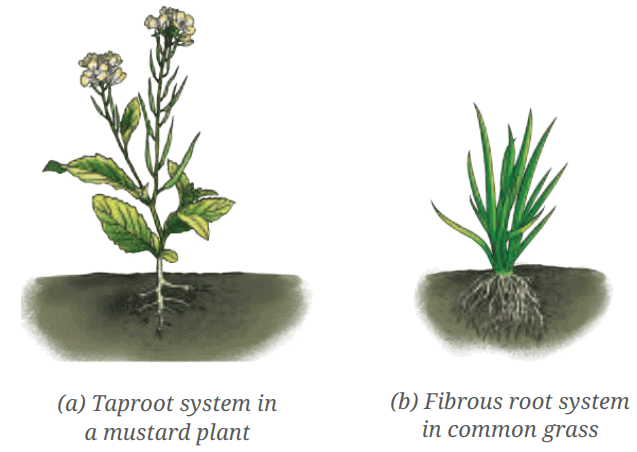 Fig 2.5: Types of roots
Fig 2.5: Types of roots
Ans: Similarities and differences in the roots of the plants are as follows: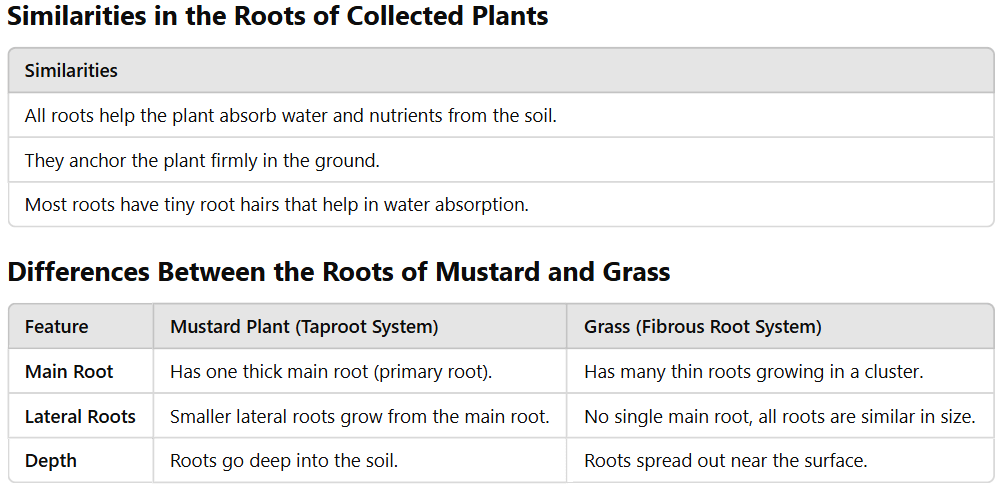
Is there any relation between the type of leaf venation and the type of root of the same plant? How do we find this out?
Ans: Yes, there is a relationship between the type of leaf venation and the root system of a plant.
- Plants with taproot systems generally have reticulate venation (net-like pattern in leaves). Example: Mustard plant.
- Plants with fibrous root systems usually have parallel venation (veins running parallel to each other). Example: Grass.
How to Find This Out?
- Observe the leaf venation of the plants collected.
- Classify the plants based on whether they have reticulate or parallel venation.
- Check their roots by gently digging them out.
- Compare the patterns: If the plant has reticulate venation, it will likely have a taproot system. If the plant has parallel venation, it will likely have a fibrous root system.
Activity 2.7: Let us relate leaf venation and roots
Activity:
- Collect saplings of five common plants from your school nursery or any other nurseries to plant in your school garden. Examples of such plants can include lemongrass, marigold, sadabahar (periwinkle), and others.
- Before planting them, observe their roots and the venation in their leaves.
- Record your observations in Table 2.4
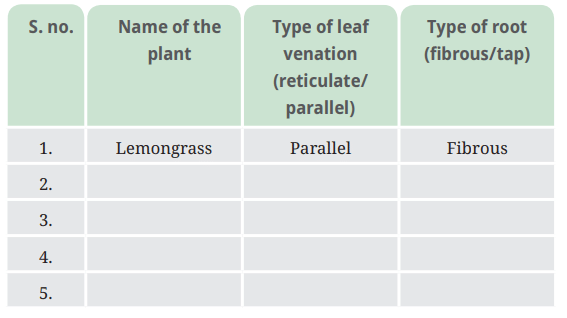 Table 2.4
Table 2.4
Ans: Observed roots and the venation in their leaves
i. Do you observe any relation between the leaf venation and types of root in these plants? Do other plants with reticulate venation have taproots too? Do other plants with parallel venation have fibrous roots too?
Ans: Yes, there is a clear relationship among the type of seed, leaf venation, and root system in plants.
Plants with Reticulate Venation Have Taproots
- Example: Sadabahar (Periwinkle), Marigold, Chickpea (Chana), Hibiscus
- These plants have net-like venation in their leaves and a single thick taproot with lateral branches.
Plants with Parallel Venation Have Fibrous Roots
- Example: Lemongrass, Wheat, Maize, Grass
- These plants have parallel venation in their leaves and many thin fibrous roots spreading out from the base.
ii. Is there any relation among the seed of a plant, types of root and leaf venation?
Ans: Plants can be classified into two main groups based on their seeds:
Dicot Plants (Two Cotyledons in Seeds)
- Have reticulate venation in leaves.
- Have taproot systems.
- Example: Chickpea, Marigold, Hibiscus, Mango
Monocot Plants (One Cotyledon in Seeds)
- Have parallel venation in leaves.
- Have fibrous root systems.
- Example: Wheat, Rice, Lemongrass, Maize
iii. Are All Seeds Similar?
Ans: No, seeds are not all the same. They differ in:
- Size: Some are large (mango), while others are small (mustard).
- Shape: Some are round (pea), while others are elongated (wheat).
- Number of Cotyledons: Some have one cotyledon (monocots), and others have two cotyledons (dicots).
Activity 2.8: Let us Compare
Activity:
- Soak some chickpea and maize seeds in water for two or three days.
- Remove the seed coat of a chickpea. Now, observe the structure of the chickpea and maize seeds. Are they similar or different?
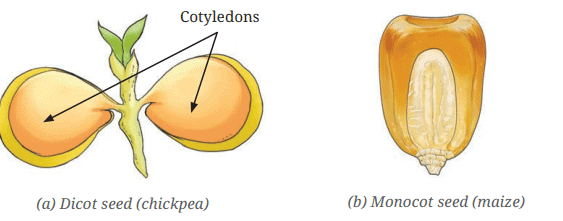 Dicot and Monocot Seed
Dicot and Monocot Seed
Ans: After soaking chickpea (chana) and maize (makka) seeds in water for two or three days, we can observe their structures by removing the seed coat.
Differences Between Chickpea and Maize Seeds
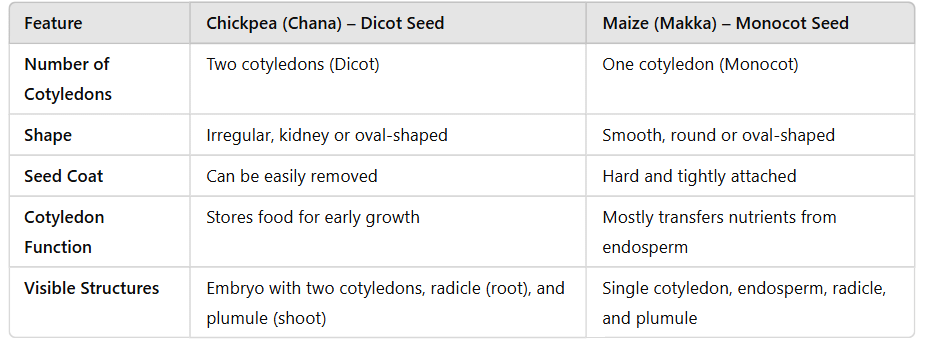
Conclusion:
- Chickpea (Dicot) has two cotyledons and shows reticulate venation in leaves.
- Maize (Monocot) has one cotyledon and shows parallel venation in leaves.
Activity 2.9: Let us find out animal movement
Activity:
- You have recorded the movement of a few animals in Table 2.2. You may have also observed how other animals move from place to place. Let us now think about the types of movement in animals. A number of animals are shown in Fig. 2.7.
- You can add more animals that you may have observed and create a poster on the variety of animals. Which body parts are used by the animals in the poster you created and those in Fig. 2.7 for movement?
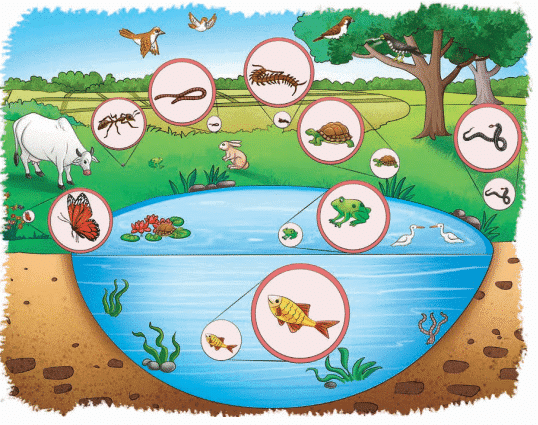 Fig 2.7
Fig 2.7
List these animals in Table 2.5. Note the ways in which these animals move and name the body parts used for movement. Some examples are given in Table 2.5.
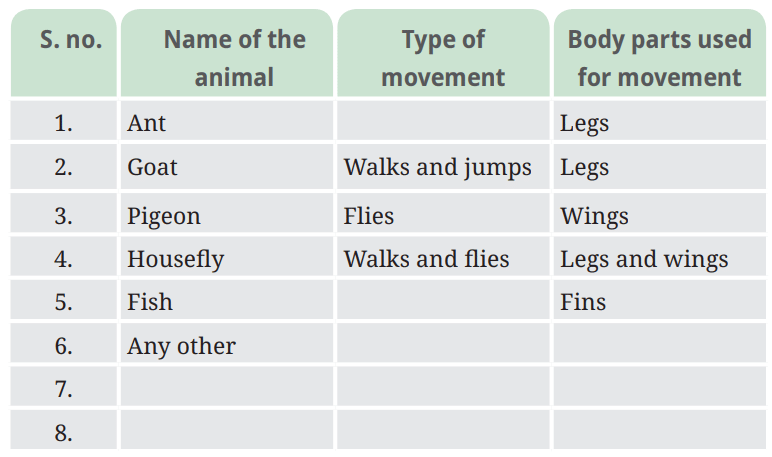 Table 2.5Ans: Movements in animals and their body parts involved
Table 2.5Ans: Movements in animals and their body parts involved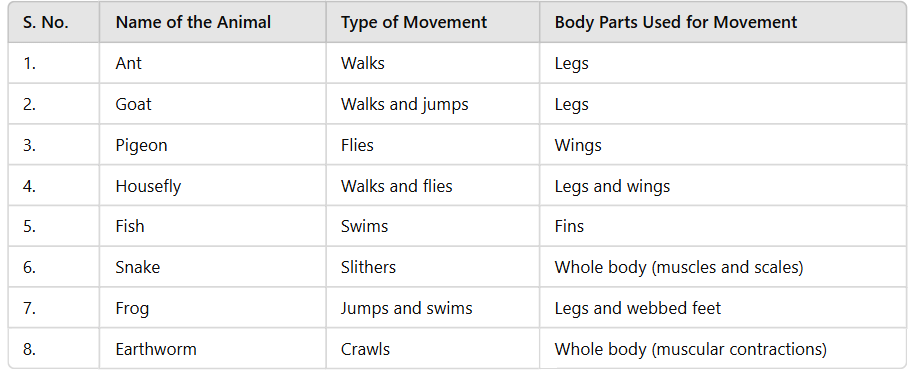
Conclusion:
- Different animals have different movement adaptations.
Activity 2.10: Let us compare and analyze habitats
Activity:
- Look at Table 2.6. Recreate a similar table on the blackboard.
- List the names of plants and animals you or your classmates have observed in these regions or already know about.
- A few examples are given. You can add more.
 Table 2.6
Table 2.6
Ans:
Conclusion:
- Plants and animals adapt to their environment.
|
67 videos|289 docs|27 tests
|
FAQs on NCERT Based Activity: Diversity in the Living World - Science for Class 6
| 1. What are the main activities involved in exploring and studying plants and animals in class 6? |  |
| 2. How can we group plants effectively in a classroom setting? |  |
| 3. What is the significance of comparing leaves in plant studies? |  |
| 4. Why is it important to study roots in plants? |  |
| 5. How do animal movements vary between different habitats? |  |

















